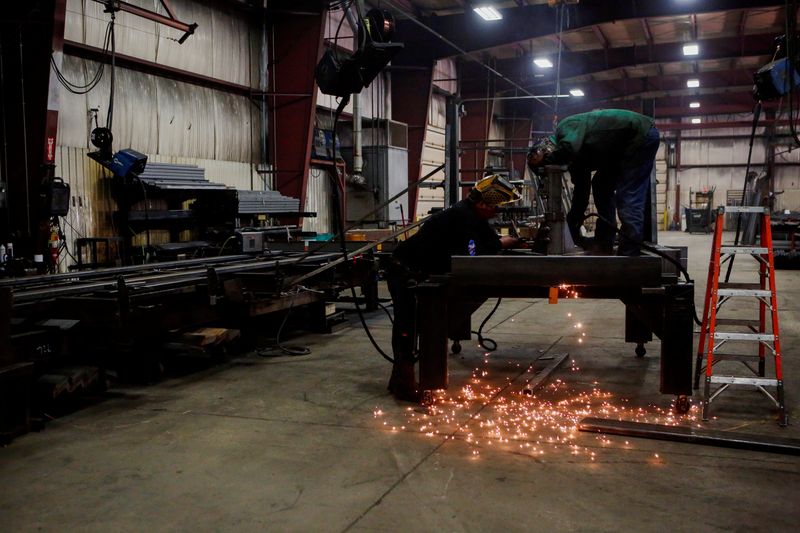WASHINGTON (Reuters) – U.S. factory activity powered ahead in early April, though manufacturers increasingly struggled to source raw materials and other inputs as a reopening economy leads to a boom in domestic demand, which could slow momentum in the months ahead.
The flow of strong economic data continued with another report on Friday showing new home sales racing to a more than 14-1/2-year high in March. The economy is being boosted by the White House’s massive $1.9 trillion COVID-19 pandemic rescue package and increased vaccinations against the virus.
Retail sales jumped to a record high in March and hiring accelerated, cementing expectations for robust growth in the first quarter and setting up the economy for what could be its best performance in nearly four decades.
Data firm IHS Markit said its flash U.S. manufacturing PMI increased to 60.6 in the first half of this month. That was the highest reading since the series started in May 2007 and followed 59.1 in March.
Economists polled by Reuters had forecast the index rising to 60.5 in early April. A reading above 50 indicates growth in manufacturing, which accounts for 11.9% of the U.S. economy.
“The U.S. economy is enjoying a strong start to the second quarter, firing on all cylinders as loosening virus restrictions, an impressive vaccine roll-out, a brighter outlook and stimulus measures all helped boost demand,” said Chris Williamson, chief business economist at IHS Markit.
More than half of American adults have had at least one vaccine dose, according to the U.S. Centers for Disease Control and Prevention (CDC). A third of U.S. adults are fully vaccinated. That, together with the fiscal stimulus, has allowed for broader economic re-engagement.
But the strong demand is pushing against supply constraints. The pandemic has disrupted labor at factories and their suppliers, causing shortages that are boosting prices of materials and other inputs.
The IHS Markit survey’s measure of prices paid by manufacturers jumped to the highest level since July 2008. It attributed the higher input prices to “severe supplier shortages and marked rises in transportation fees.”
The continued rise in input costs is one of many factors expected to drive inflation above the Federal Reserve’s 2% inflation target this year. Fed Chair Jerome Powell has expressed confidence that the supply chains will adapt and become more efficient, and prevent prices from remaining higher for a sustained period.
According to IHS Market supply shortages were causing backlogs of uncompleted work “of a magnitude not surpassed for over seven years.” The raw material squeeze is most evident in the automobile industry, where a global semiconductor shortage has forced production cuts at motor vehicle assembly plants.
Supply challenges have also spilled over to the housing market, where builders are struggling with record lumber prices, threatening to worsen an already acute shortage of previously owned homes available for sale.
A report from the Commerce Department on Friday showed new single-family home sales surged 20.7% to a seasonally adjusted annual rate of 1.021 million units last month, the highest since August 2006.
The sales pace blew past economists’ expectations for 886,000 units. The market for new homes is benefiting from the dearth of previously owned home.
“Demand is causing new homes to be bought virtually as soon as they hit the market,” said from Robert Frick, corporate economist at Navy Federal Credit Union in Vienna, Virginia.
The data helped to lift stocks on Wall Street. The dollar fell against a basket of currencies. U.S. Treasury prices were lower.
TIGHT INVENTORY
The pandemic is driving demand for bigger and more expensive accommodations as millions of Americans continued to work from home and attend classes remotely. Homebuilders, however, are also grappling with shortages of land and workers.
New home sales are drawn from a sample of houses selected from building permits. Sales soared 66.8% year-on-year in March.
Sales surged in the South, Midwest and Northeast, but fell in the West. They were concentrated in the $200,000-$399,999 price range. Sales below the $200,000 price bracket, the sought-after segment of the market, accounted for only 3% of transactions last month.
The median new house price rose 0.8% from a year earlier to $330,800 in March. The National Association of Realtors reported on Thursday that sales of previously owned homes declined for a second straight month in March, with prices hitting an all-time high as supply remained near record lows.
There were 307,000 new homes on the market last month, unchanged from February. At March’s sales pace it would take 3.6 months to clear the supply, down from 4.4 months in February.
“Inventories remain tight and while that should be a positive for home building activity, a lack of availability will likely remain a headwind for sales in the near term,” said Rubeela Farooqi, chief U.S. economist at High Frequency Economics in White Plains, New York.
About 74% of homes sold last month were either under construction or yet to be built.
(Reporting by Lucia Mutikani; Editing by Chizu Nomiyama)

























